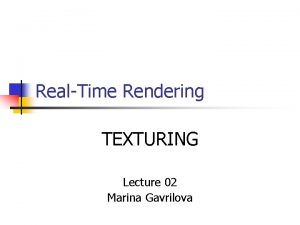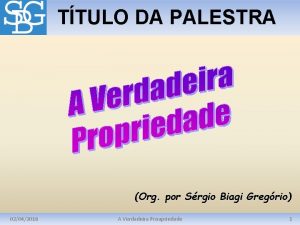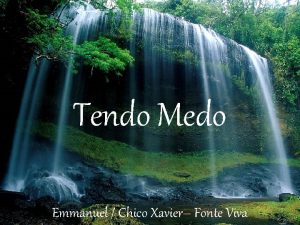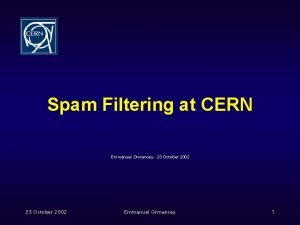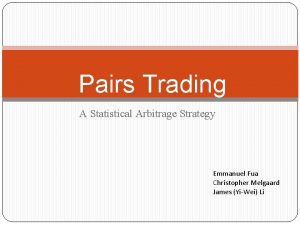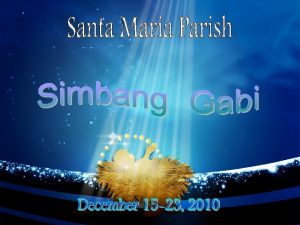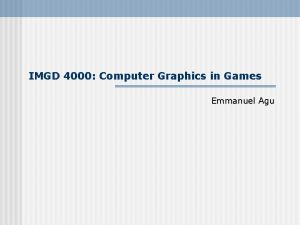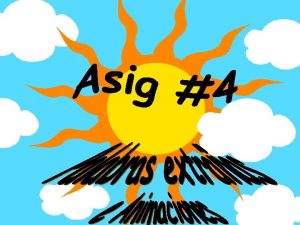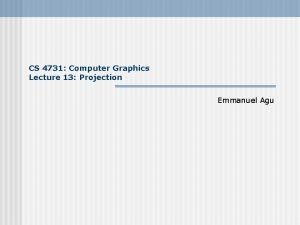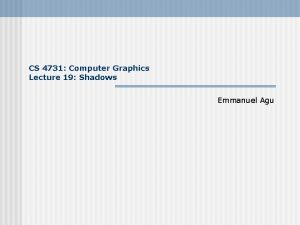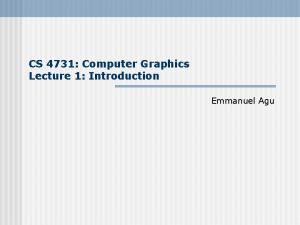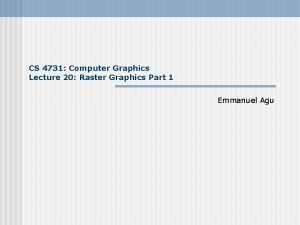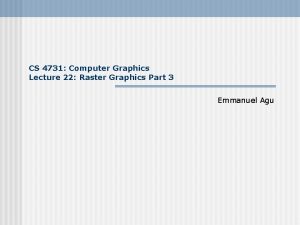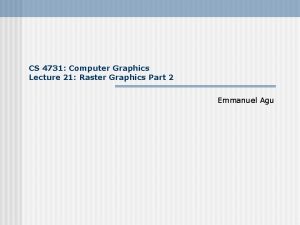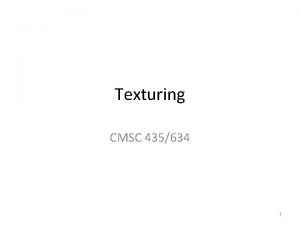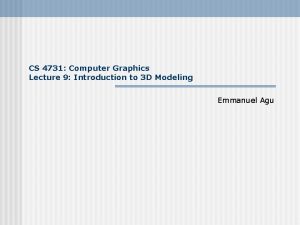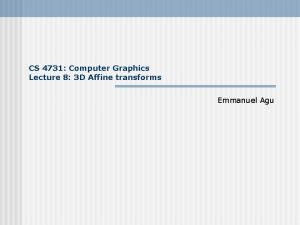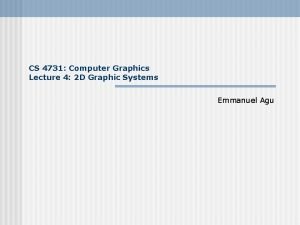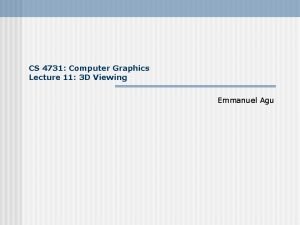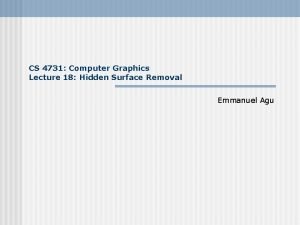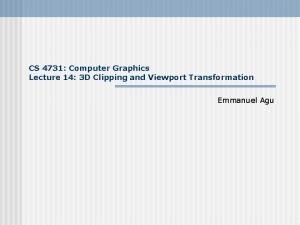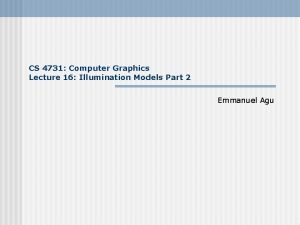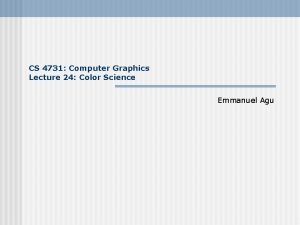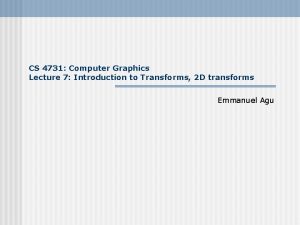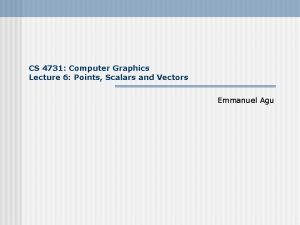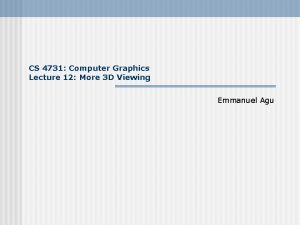CS 4731 Computer Graphics Lecture 17 Texturing Emmanuel





















- Slides: 21

CS 4731: Computer Graphics Lecture 17: Texturing Emmanuel Agu

Announcement n n Help session for project 4 today FL 320, 5 -6 pm

Texture Mapping n n A way of adding surface details Two ways can achieve the goal: v Surface detail polygons: create extra polygons to model object details v Add scene complexity and thus slow down the graphics rendering speed v Some fine features are hard to model! ü Map a texture to the surface (a more popular approach) Complexity of images does Not affect the complexity Of geometry processing (transformation, clipping…)

Texture Mapping 1. projection 3. patch texel 3 D geometry 2. texture lookup 2 D projection of 3 D geometry t 2 D image S

Texture Representation ü Bitmap (pixel map) textures (supported by Open. GL) n Procedural textures (used in advanced rendering programs) Bitmap texture: q A 2 D image - represented by 2 D array (1, 1) t q q q s (0, 0) texture[height][width] Each pixel (or called texel ) by a unique pair texture coordinate (s, t) The s and t are usually normalized to a [0, 1] range For any given (s, t) in the normalized rang there is also a unique image value (i. e. , a unique [red, green, blue] set )

Texture Value Lookup n For given texture coordinates (s, t), we can find a unique image value from the texture map (1, 1) How about coordinates that are not exactly at the intersection (pixel) position A) Nearest neighbor B) Linear Interpolation C) Other filters (0, 0) (0. 25, 0)(0. 75, 0) (1, 0)

Map textures to surfaces n Establish mapping from texture to surfaces (polygons): - Application program needs to specify texture coordinates for each corner of the polygon (1, 0) (1, 1) The polygon can be in an arbitrary size (0, 0) (1, 0)

Map textures to surfaces n Texture mapping is performed in rasterization (0, 1) (1, 1) q For each pixel that is to be painted, its texture coordinates (s, t) are determined (interpolated) based on the corners’ texture coordinates (why not just interpolate the color? ) q The interpolated texture (0, 0) (1, 0) coordinates are then used to perform texture lookup

Open. GL texture mapping n Texturing steps in your program 1) Specify texture - read or generate image Assign to texture 2) Specify texture mapping parameters - Wrapping, filtering, etc. 3) Enable GL texture mapping (GL_TEXTURE_2 D) 4) Assign texture coordinates to vertices 5) Disable GL texture mapping (if you don’t need to perform texture mapping any more)

Specify textures Load the texture map from main memory to texture memory n q gl. Tex. Image 2 D(Glenum target, Glint level, Glint iformat, int width, int height, Glenum format, Glenum type, Glvoid* img) Example: n q gl. Teximage 2 D(GL_TEXTURE_2 D, 0, GL_RGB, 64, GL_RGB, GL_UNSIGNED_BYTE, my. Image); (my. Image is a 2 D array: GLu. Byte my. Image[64][3]; ) § The dimensions of texture images must be powers of 2

Fix texture size n If the dimensions of the texture map are not power of 2, you can 1) Pad zeros 2) use glu. Scale. Image() 60 100 Ask Open. GL to filter the data for you to the right size – you can specify the output resolution that you want 128 Remember to adjust the texture coordinates for your polygon corners – you don’t want to Include black texels in your final picture 64

Texture mapping parameters n What happen if the given texture coordinates (s, t) are outside [0, 1] range? (0, 0) texture n (2, 2) (1, 1) (0, 0) GL_Repeat E. g: gl. Tex. Parameteri(GL_TEXTAURE_2 D, GL_TEXTURE_WRAP_S, GL_CLAMP) GL_Clamp If (s >1) s = 1 If (t >1) t = 1

Texture mapping parameters n Since a polygon can get transformed to arbitrary screen size, texels in the texture map can get magnified or minified. texture polygon projection Magnification n texture polygon projection Minification Filtering: interpolate a texel value from its neighbors or combine multiple texel values into a single one

Texture mapping parameters n Open. GL texture filtering: 1) Nearest Neighbor (lower 2) image quality) 3) 4) 2) Linear interpolate the neighbors (better quality, slower) gl. Tex. Parameteri(GL_TEXTURE_2 D, GL_TEXTURE_MIN_FILTER, GL_NEAREST); GL_TEXTURE_MIN_FILTER, GL_LINEAR) Or GL_TEXTURE_MAX_FILTER

Texture color blending n Determine how to combine the texel color and the object color n n GL_MODULATE – multiply texture and object color GL_BLEND – linear combination of texture and object color GL_REPLACE – use texture color to replace object color E. g: gl. Tex. Envf(GL_TEXTURE_ENV, GL_TEXTURE_ENV_MODE, GL_REPLACE);

Enable (Disable) Textures n n n Enable texture – gl. Enable(GL_TEXTURE_2 D) Disable texture – gl. Disable(GL_TEXTURE_2 D) Remember to disable texture mapping when you draw non-textured polygons

Specify texture coordinates n Give texture coordinates before defining each vertex gl. Begin(GL_QUADS); gl. Tex. Coord 2 D(0, 0); gl. Vertex 3 f(-0. 5, 0, 0. 5); … gl. End();

Transform texture coordinates n n All the texture coordinates are multiplied by Gl_TEXTURE matrix before in use To transform texture coordinates, you do: n n n gl. Matrix. Mode(Gl_TEXTURE); Apply regular transformation functions Then you can draw the textured objects

Put it all together … gl. Tex. Parameteri(GL_TEXTURE_2 D, GL_TEXTURE_WRAP_S, GL_REPEAT); gl. Tex. Parameteri(GL_TEXTURE_2 D, GL_TEXTURE_WRAP_T, GL_REPEAT); gl. Tex. Parameteri(GL_TEXTURE_2 D, GL_TEXTURE_MAG_FILTER, GL_NEAREST); gl. Tex. Parameteri(GL_TEXTURE_2 D, GL_TEXTURE_MIN_FILTER, GL_NEAREST); gl. Tex. Envf(GL_TEXTURE_ENV, GL_TEXTURE_ENV_MODE, GL_REPLACE); … gl. Enable(GL_TEXTURE_2 D); gl. Tex. Image 2 D(GL_TEXTURE_2 D, 0, GL_RGB, 64, 0, GL_RGB, GL_UNSIGNED_BYTE, mytexture); Draw_picture 1(); // define texture coordinates and vertices in the function ….

Other Stuff n Wrapping texture onto curved surfaces. E. g. cylinder, can, etc n Wrapping texture onto sphere n Bump mapping: perturb surface normal by a quantity proportional to texture

References n Hill, 8. 5
 Cs 4731
Cs 4731 Texturing
Texturing Hand held computer
Hand held computer Graphics hardware in computer graphics ppt
Graphics hardware in computer graphics ppt 01:640:244 lecture notes - lecture 15: plat, idah, farad
01:640:244 lecture notes - lecture 15: plat, idah, farad Computer security 161 cryptocurrency lecture
Computer security 161 cryptocurrency lecture Computer aided drug design lecture notes
Computer aided drug design lecture notes Computer architecture notes
Computer architecture notes Isa definition computer
Isa definition computer A verdadeira propriedade emmanuel
A verdadeira propriedade emmanuel Medo emmanuel
Medo emmanuel Emmanuel spammer
Emmanuel spammer Emmanuel fua
Emmanuel fua Emmanuel beam
Emmanuel beam Emmanuel monod
Emmanuel monod Emmanuel menanteau
Emmanuel menanteau Emmanuel garant peintre
Emmanuel garant peintre Berkeley international office
Berkeley international office Muitos os chamados e poucos os escolhidos emmanuel
Muitos os chamados e poucos os escolhidos emmanuel E m m a n u e l
E m m a n u e l La musique est la langue des émotions explication
La musique est la langue des émotions explication Emmanuel agu
Emmanuel agu

